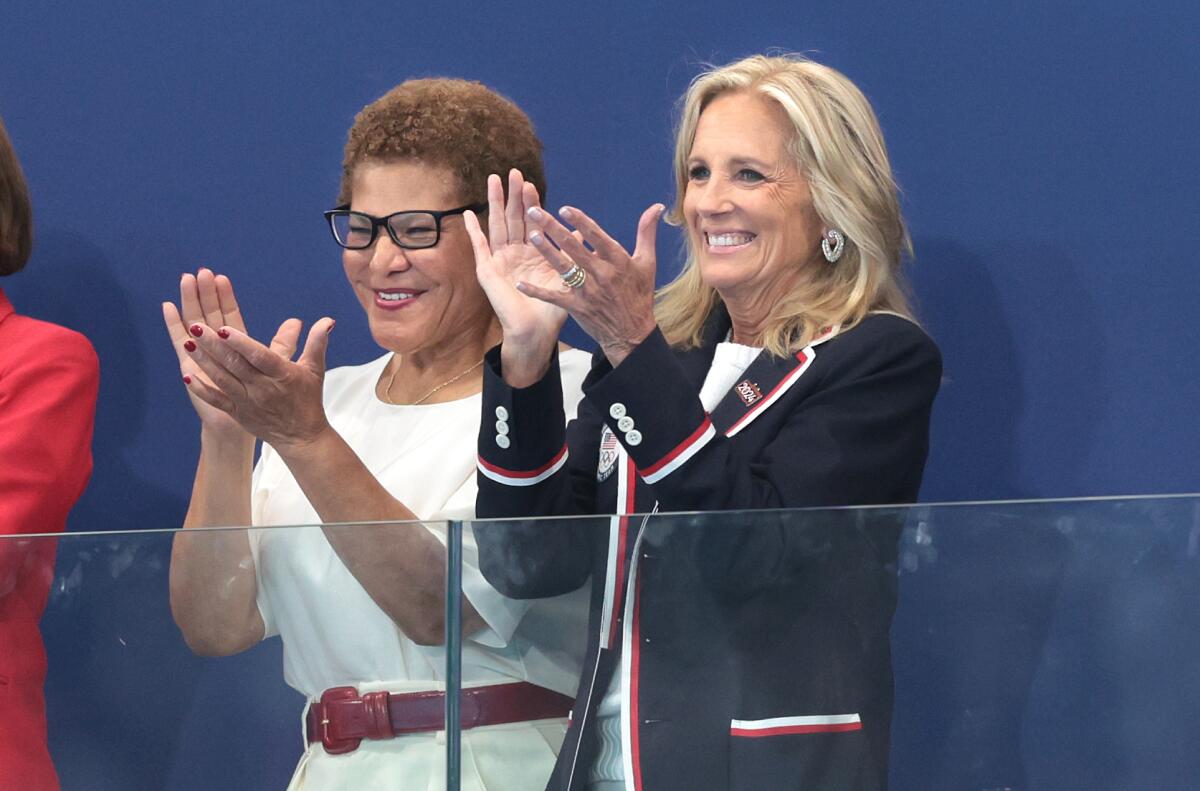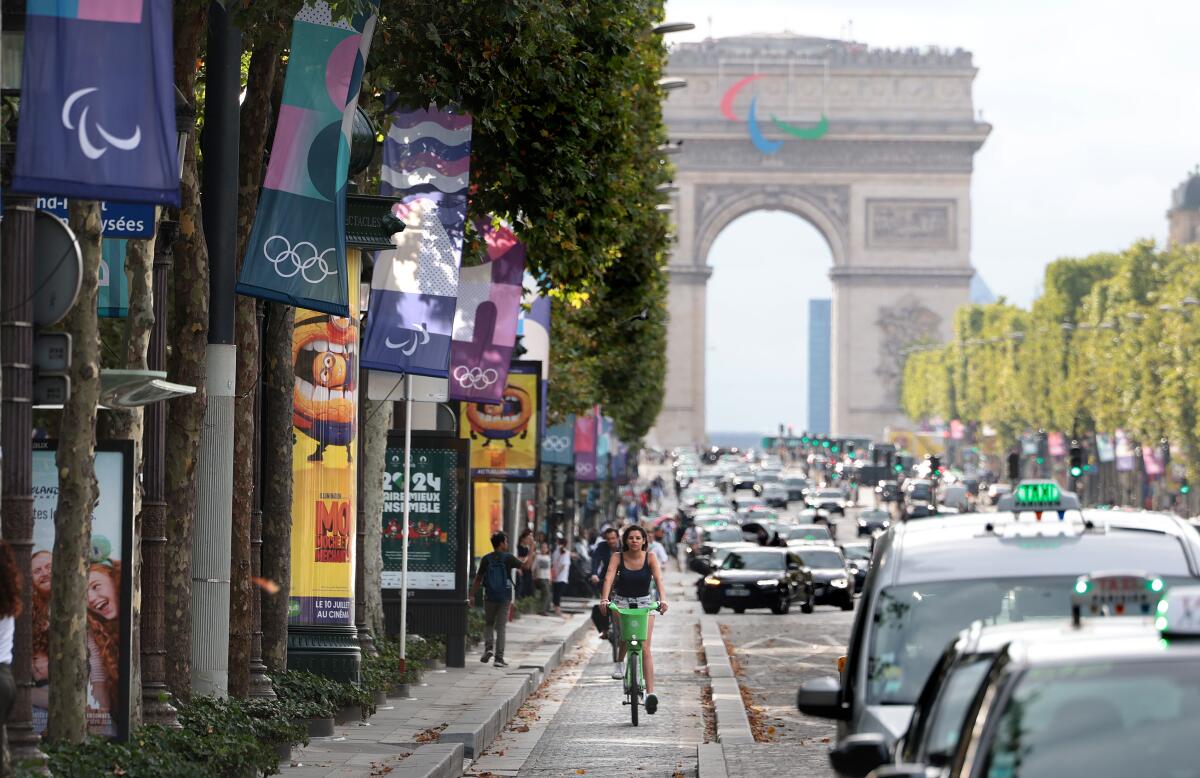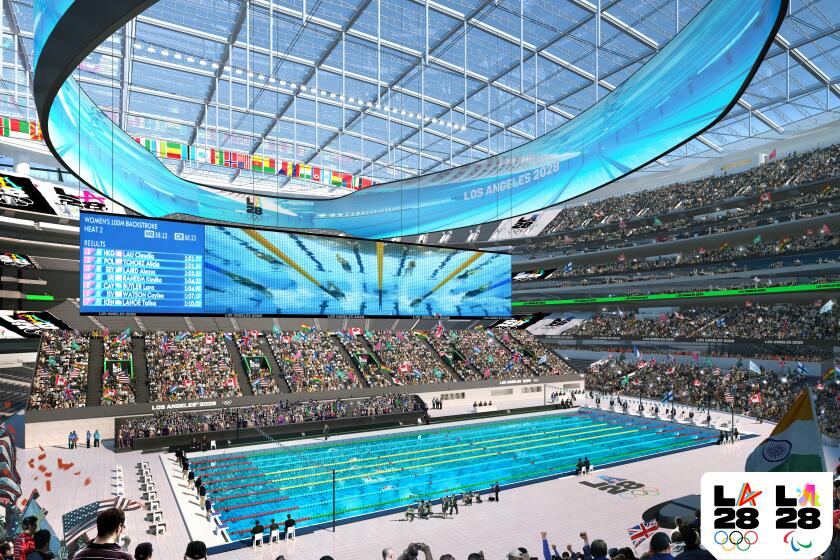L.A. Mayor Karen Bass outlines vision for (almost) ‘car-free’ Olympics

- Share via
PARIS — Rush hour all but disappeared. There was less traffic on the freeways and not as much stop-and-go on surface streets.
Longtime residents of Southern California remember that, in terms of driving, the 1984 Summer Olympics felt something like heaven. Businesses switched to staggered schedules. Lots of people left town for a few weeks.
Now, with the world’s biggest sports competition set to return in four years, Mayor Karen Bass wants to go a step further.
“A no-car Games,” she said.
Doubling down on something she discussed with The Times in April, Bass told reporters at the 2024 Paris Olympics that she envisions expanding public transportation to a point where fans can take trains and buses to dozens of sports venues, from Crypto.com Arena downtown to SoFi Stadium in Inglewood to the beaches of Santa Monica.
“That’s a feat in Los Angeles — we’ve always been in love with our cars,” she said at a news conference Saturday, adding that people “will have to take public transportation to get to all the venues.”
The LA28 organizing committee — a private group charged with staging the Games — prefers to say it is planning a “public-transit-first” Games. Some venues will have ample parking, others will not. Organizers say no one will be told they cannot drive to a competition, but public transportation might be an easier option.
The Olympics are expected to draw a crush of visitors to the region in 2028. Bass, city staff and LA28 executives have made multiple trips to France, eager to see what officials here are doing well. Or not so well.
Paris is dealing with an influx of thousands of athletes, tens of thousands of coaches and officials and an estimated 15 million people expected to pass through during the Olympics and Paralympics, which end in early September.
The French capital has relied heavily on its established, efficient Metro system. Subway cars run every few minutes with bright pink signage informing passengers where to disembark for short walks to various stadiums and arenas.

Still, Parisians have complained about heavy traffic, with drives that should take 20 minutes stretching well past an hour. Security measures have required multiple road closures.
For 2028, Bass plans to meet with major employers throughout Southern California to discuss the possibility of once again staggering work hours, a strategy Mayor Tom Bradley used to great effect almost 40 years ago.
These are different times — replete with cellphones, laptops and Wi-Fi — so Bass also wants as many people as possible to work from home, much as they did during the pandemic lockdown.
Businesses “learned from COVID that we do have essential workers, people that must come to work,” she said. “There might be some employers that we would say: ‘Could you be remote for 17 days?’”
Los Angeles officials are trying to figure out how to pay more than $1 billion to run buses that will probably disappear after the Games.
Southern California cannot hope to match Paris in terms of public transport. Not with the current state of its bus and rail system. Not with a vast geographical footprint that will see Olympic events held in Long Beach and Carson, the San Fernando Valley and Temecula.
LA28 has been considering a variety of strategies to avoid traffic jams and long waits for commuters.
SoFi, hosting the opening ceremony and swimming, may allow fans to park in its expansive lots. Same with Dodger Stadium and the Rose Bowl, which have not been named as venues but are expected to be added soon.
Other venues such as the Riviera Country Club for golf and the Coliseum for track and field will have little to no on-site parking.
Bass said more than 3,000 buses will be brought into L.A. from across the country to help with moving fans, linking venues to temporary satellite parking.
Planners have estimated the overall cost for this could surpass $1 billion. Sen. Alex Padilla (D-Calif.) announced last month that he has secured an initial $200 million in federal funding for the bus leasing program, and more such help is expected.
Olympic swimming events at SoFi Stadium? Yes, say 2028 Olympic organizers, who plan to hold events at venues that will provide more seats and raise more money.
Overall, LA28 has estimated that the Games will cost about $7 billion — a figure that is likely to rise in the next four years. Organizers have vowed to balance their budget through International Olympic Committee contributions, corporate sponsorships, ticket sales and other revenue sources.
Dealing with traffic in the summer of 2028 will require cooperation among cities and at every level of government, Bass said. On the day before the Olympics closing ceremony in Paris, she referenced 1984 in expressing confidence that L.A. can handle what lies ahead.
“Angelenos were terrified that we were going to have terrible, terrible traffic,” Bass said. “We were shocked that we didn’t.”
More to Read
Go beyond the scoreboard
Get the latest on L.A.'s teams in the daily Sports Report newsletter.
You may occasionally receive promotional content from the Los Angeles Times.









